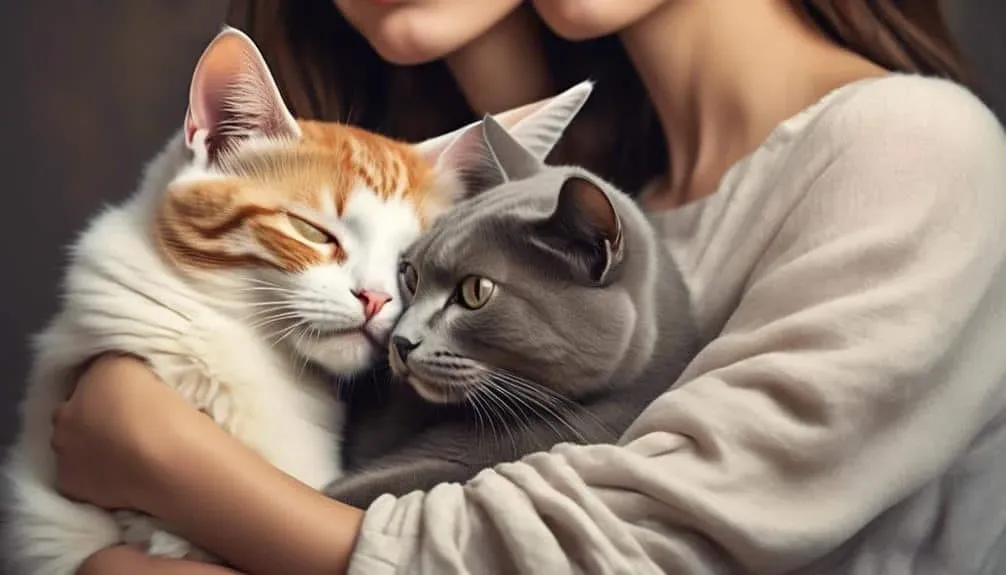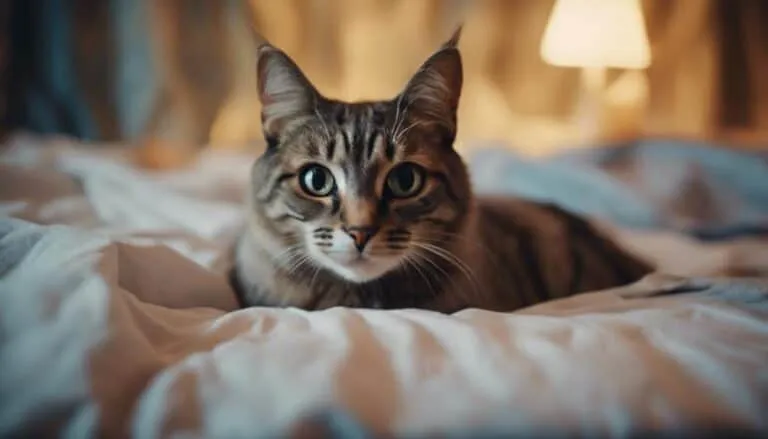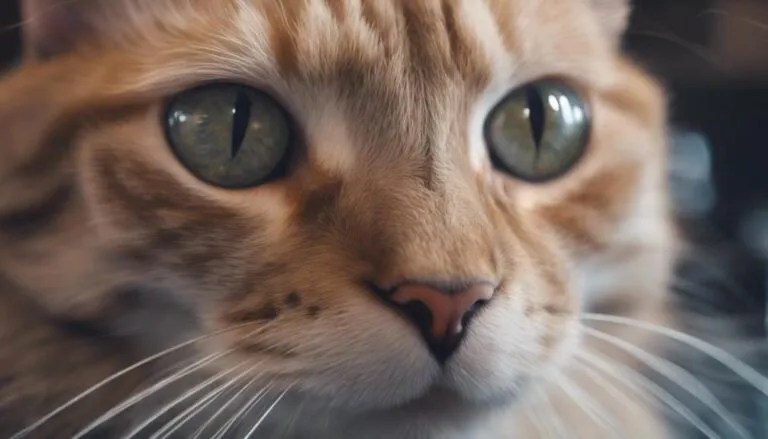The Best Fluffy Pancakes recipe you will fall in love with. Full of tips and tricks to help you make the best pancakes.

Have you ever wondered if cats truly think of humans as their mothers?
It's a theory that has captivated cat lovers for ages, as we try to decipher the intricate and mysterious world of feline behavior. As we observe their interactions and attempt to understand their perception, we find ourselves intrigued by the possibility of a deeper connection between cats and humans.
Are we simply seen as providers, or is there something more profound at play?
Join us as we embark on a journey to unravel the complexities of feline perception and uncover the truth behind this intriguing theory.
Key Takeaways
- Cats view humans as a different kind of cat and use the same body language with humans as they do with other cats.
- Cats meow at humans as a way to communicate, potentially because they view us as their mother or a different kind of cat.
- Cats show affection to their mother by meowing and rubbing on her, and kittens may also exhibit similar behavior towards humans.
- While the extent to which cats view humans as mother figures is unclear, cats form strong bonds with humans and little consideration is given to maternal connections.
Cats' Perception of Humans as Cats
Cats perceive humans as a different kind of cat, using the same body language and treating us in a similar manner as they do with other cats. This behavior towards humans suggests that cats may view us as part of their social group.
They exhibit similar behaviors such as rubbing against our legs, kneading on us, and even grooming us. This behavior is indicative of the close bond that cats form with their fellow feline companions.
It's interesting to note the similarities between cats and humans in terms of social interactions. Cats' behavior towards humans reflects their innate social nature and their ability to form connections with individuals outside their own species.
Understanding these behaviors can help us better serve and care for our feline friends.
Meowing as Communication With Humans
Meowing serves as a form of communication between cats and humans, allowing cats to express their needs, desires, and emotions. The evolution of meowing as a form of communication with humans can be traced back to the domestication of cats. While wild cats primarily communicate through body language and scent marking, domesticated cats have developed meowing as a way to interact with humans.
Meowing has become a learned behavior, as cats have recognized that humans respond to their vocalizations. This form of communication strengthens the bond between cats and humans, as it allows for mutual understanding and responsiveness.
Cats' Relationship With Their Mother
Research suggests that cats form strong bonds with their mothers during their early stages of life. These bonds are characterized by behaviors such as meowing and rubbing against their mother. The mother cat provides essential care, including nourishment and teaching important skills.
The absence of a mother cat during this critical period can have long-lasting effects on a kitten's development. It can potentially lead to behavioral and emotional issues later in life.
It's important to understand the significance of the mother's role in a cat's life and ensure proper care and nurturing for healthy emotional and behavioral development.
Cats' Perception of Birth and Origins
The perception of birth and origins in cats is a topic that raises questions about their understanding of their own beginnings. The role of maternal behavior in cat development plays a significant role in shaping their perception.
Mother cats exhibit maternal behaviors, such as nursing, grooming, and protection, that contribute to the kittens' growth and development. These behaviors create a bond between the mother and her offspring.
However, the impact of human interaction on a cat's perception of birth and origins is also noteworthy. Humans often take on the role of caregivers and provide the necessary care and nurturing for newborn kittens. This interaction may influence how cats perceive their own birth and origins, blurring the line between human and feline maternal figures.
Further research is needed to fully understand the extent of this impact and how cats perceive their own origins in the presence of human caregivers.
Cats' View of Humans as Mother Figures
The impact of human interaction on a cat's perception of birth and origins raises questions about how cats view humans as mother figures. Understanding the cats' bond with humans compared to other animals is essential in exploring this topic. Additionally, the role of human caregivers in the development of kittens without mothers is crucial to consider.
Cats' bond with humans compared to other animals:
- Cats form strong emotional bonds with humans, similar to the way they bond with other cats.
- Cats treat humans as competent caretakers and may see them as a sort of mother figure.
- The extent to which cats view humans as mother figures is still unclear and challenging to determine.
The role of human caregivers in the development of kittens without mothers:
- Kittens without mothers may rely on humans for care and nourishment.
- Human caregivers can act as surrogate mothers to orphaned kittens, providing the necessary support and nurturing.
- The lack of a mother cat can impact the development of young kittens, making human caregivers crucial in their growth.
Understanding these aspects can shed light on the complex dynamics of cats' view of humans as mother figures and the importance of human caregiving in their lives.
Uncertainty Around Cats' Perception of Humans as Mothers
There is considerable uncertainty surrounding the perception of cats towards humans as their mothers. While cats may form strong attachments to humans, it's unclear whether they view humans as substitute mothers or simply as competent caretakers.
Compared to other animals, cats have a unique relationship with humans, treating them similarly to how they treat other cats. However, the role of human interaction in shaping cats' behavior and perception can't be ignored. Human caregivers often act as surrogate mothers to orphaned kittens, and young kittens without mothers may assume that all cats are raised by human mothers.
It's important to note that cats focus more on immediate needs and living in the moment, rather than pondering their origins or maternal connections.
Further research is needed to better understand cats' perception of humans as mothers and the impact of human interaction on their behavior.
Complex Behavior of Cats
Cats exhibit a wide range of complex behaviors that are shaped by their unique relationship with humans and their innate instincts. Understanding these behaviors can help us better communicate and bond with our feline companions.
Cats' social behavior with other cats:
- Cats are social animals, and their interactions with other cats play a crucial role in shaping their behavior.
- They communicate through body language, such as tail movements, ear positions, and vocalizations.
The role of body language in cat communication:
- Cats rely heavily on body language to express their thoughts and emotions.
- For example, a raised tail indicates friendliness, while a lowered tail suggests fear or aggression.
- Understanding these subtle cues can help us interpret their intentions and respond accordingly.
The complexity of cat behavior:
- Cats' behavior isn't solely determined by their social interactions with other cats but also influenced by their relationship with humans.
- They form strong bonds with their human caregivers, displaying affectionate behaviors like rubbing against us or purring.
- This suggests that cats view humans as important companions, although their perception of us as 'mothers' is still uncertain.
Impact of Lack of Mother on Young Kittens
When young kittens are deprived of a mother figure, their development and well-being can be significantly impacted.
The absence of a mother cat can have various developmental consequences on these vulnerable kittens. Without a mother's guidance, kittens may struggle to learn essential skills such as grooming, hunting, and socialization.
The lack of maternal care can also affect their emotional and psychological well-being, potentially leading to behavioral problems in adulthood.
In such cases, human caregivers often step in as surrogate mothers to provide the necessary care and nourishment. This intervention can mitigate some of the negative effects of maternal deprivation.
However, it's crucial to note that human caregivers may not fully replicate the complex interactions and behaviors exhibited by a feline mother.
Further research is needed to understand the long-term impact of surrogate mothering on the development of young kittens and how to best support their well-being.
Frequently Asked Questions
How Do Cats Perceive Humans as Cats?
Cats perceive humans as a different kind of cat. They interact with us using the same body language as they do with other cats. Their feline perception of humans is complex and not fully understood.
Why Do Cats Meow at Humans as a Form of Communication?
Cats meow at humans as a form of communication. Understanding cat-human communication involves recognizing that meowing is a way for cats to express their needs and wants to us.
Do Cats Treat Their Actual Mother the Same Way They Treat Humans?
Cats do not treat their actual mothers the same way they treat humans. While they may show some maternal behavior towards humans, their relationship with humans is different and they do not view humans as their mothers.
Do Cats Think About Their Origins and Who Gave Birth to Them?
Cats' perception of their origins and their understanding of their maternal relationship are unclear. They focus on immediate needs and forming bonds with humans, rather than contemplating who gave birth to them.
How Do Young Kittens Without Mothers Perceive the Role of Humans as Parents?
Young kittens without mothers may perceive human caregivers as their parents due to their reliance on them for care and nourishment. They may form an emotional bond with their human parents, viewing them as their primary caregivers.
Conclusion
In conclusion, our exploration into the world of feline behavior has revealed intriguing insights about cats' perception of humans as their mothers.
Through their communication, relationships with their biological mothers, and understanding of birth and origins, it's evident that cats may view humans as mother figures.
However, the complex and enigmatic nature of cats' behavior leaves room for uncertainty. Further research and analysis are necessary to fully understand the intricacies of their perception.








